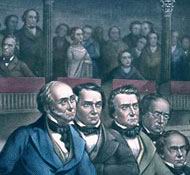A RENOWNED FORUM
What makes Henry Clay in the U.S. Senate so remarkable? It is one of only three known paintings set in the venerable Old Senate Chamber. No early photographs of the room exist, but the political scenes that took place there fascinated the nation and were frequently depicted in engravings. Artists, reporters, and Washington's elite crowded the galleries to observe the impassioned oratory and compromises that took place in the Senate's early Chamber.
This renowned setting happened to suit the artist’s own convictions that local artists should paint scenes from American history and celebrate national patriots and virtues. Staunton participated in a movement of artists that sought to cultivate scenes from America's past and promote their display in civic institutions. During the National Convention of Artists held in Washington, D.C. in 1858, these artists voiced their patriotic desire “to commemorate the past, illustrate the present, and illuminate the track to a glorious future” through “art intended for the adornment of our National buildings.”
View other scenes set in the Old Senate Chamber:
"The Senate Chamber is open to view, and the whole scene is represented with a perfect fidelity, and with a vigor and breadth of effect which, at once, attracts and enchains attention.”
Reminiscences of the Life and Character of Col. Phineas Staunton, 1867

The United States Senate, A.D. 1850. (detail)
During debates, the Chamber's galleries
would fill to capacity. This engraving
shows the crowds that gathered for Henry
Clay's speech on the Compromise of 1850.

